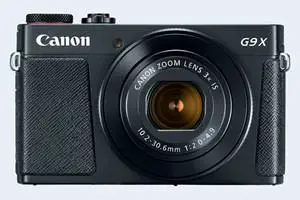Canon G9 X Mark II vs SX710
The Canon PowerShot G9 X Mark II and the Canon PowerShot SX710 HS are two digital cameras that were officially introduced, respectively, in January 2017 and January 2015. Both the G9X Mark II and the SX710 are fixed lens compact cameras that are based on an one-inch (G9X Mark II) and a 1/2.3-inch (SX710) sensor. The G9X Mark II has a resolution of 20 megapixels, whereas the SX710 provides 20.2 MP.
Below is an overview of the main specs of the two cameras as a starting point for the comparison.

Check G9X Mark II offers at
ebay.com

Check SX710 offers at
ebay.com
Going beyond this snapshot of core features and characteristics, what are the differences between the Canon PowerShot G9 X Mark II and the Canon PowerShot SX710 HS? Which one should you buy? Read on to find out how these two cameras compare with respect to their body size, their imaging sensors, their shooting features, their input-output connections, and their reception by expert reviewers.
Body comparison
The side-by-side display below illustrates the physical size and weight of the Canon G9 X Mark II and the Canon SX710. The two cameras are presented according to their relative size. Three consecutive views from the front, the top, and the rear side are shown. All width, height and depth dimensions are rounded to the nearest millimeter.
The G9X Mark II can be obtained in two different colors (black, silver), while the SX710 is also available in two color-versions, but different ones (black, red).
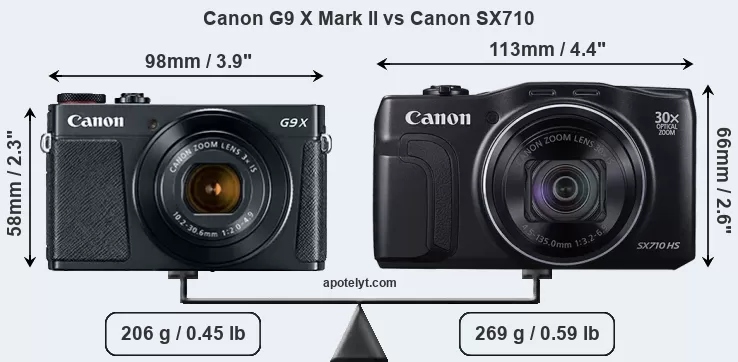
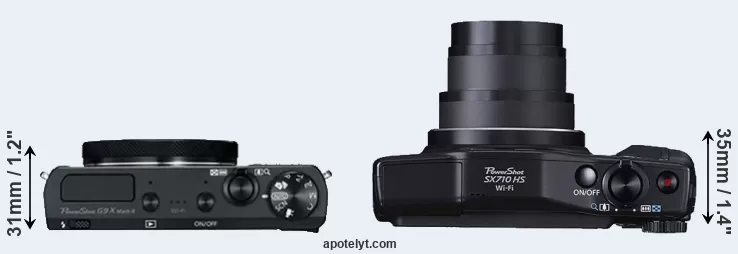
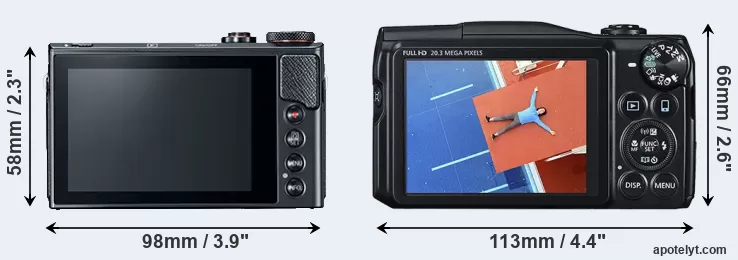
If the front view area (width x height) of the cameras is taken as an aggregate measure of their size, the Canon SX710 is notably larger (31 percent) than the Canon G9 X Mark II. Moreover, the SX710 is markedly heavier (31 percent) than the G9X Mark II. In this context, it is worth noting that neither the G9X Mark II nor the SX710 are weather-sealed.
Concerning battery life, the G9X Mark II gets 235 shots out of its Canon NB-13L battery, while the SX710 can take 230 images on a single charge of its Canon NB-6LH power pack. The power pack in the G9X Mark II can be charged via the USB port, so that it is not always necessary to take the battery charger along when travelling.
The table below summarizes the key physical specs of the two cameras alongside a broader set of comparators. If you want to switch the focus of the display and review another camera pair, you can move across to the CAM-parator tool and choose from the broad selection of possible camera comparisons there.

| Camera Model |
Camera Width |
Camera Height |
Camera Depth |
Camera Weight |
Battery Life |
Weather Sealing |
Camera Launch |
Launch Price (USD) |
Street Price |
||
|---|---|---|---|---|---|---|---|---|---|---|---|
| 1. | Canon G9 X Mark II | 98 mm | 58 mm | 31 mm | 206 g | 235 | n | Jan 2017 | 529 | ebay.com | |
| 2. | Canon SX710 | 113 mm | 66 mm | 35 mm | 269 g | 230 | n | Jan 2015 | 349 | ebay.com | |
| 3. | Canon 200D | 122 mm | 93 mm | 70 mm | 453 g | 650 | n | Jun 2017 | 549 | ebay.com | |
| 4. | Canon 1300D | 129 mm | 101 mm | 78 mm | 485 g | 500 | n | Mar 2016 | 449 | ebay.com | |
| 5. | Canon 2000D | 129 mm | 101 mm | 78 mm | 475 g | 500 | n | Feb 2018 | 449 | amazon.com | |
| 6. | Canon G7 X | 103 mm | 60 mm | 40 mm | 304 g | 210 | n | Sep 2014 | 699 | ebay.com | |
| 7. | Canon G7 X Mark II | 106 mm | 61 mm | 42 mm | 319 g | 265 | n | Feb 2016 | 699 | ebay.com | |
| 8. | Canon G9 X | 98 mm | 58 mm | 31 mm | 209 g | 220 | n | Oct 2015 | 529 | ebay.com | |
| 9. | Canon M100 | 108 mm | 67 mm | 35 mm | 302 g | 295 | n | Aug 2017 | 499 | ebay.com | |
| 10. | Canon S120 | 100 mm | 59 mm | 29 mm | 217 g | 230 | n | Aug 2013 | 449 | ebay.com | |
| 11. | Canon SX70 | 127 mm | 91 mm | 117 mm | 608 g | 325 | n | Sep 2018 | 549 | amazon.com | |
| 12. | Canon SX420 | 104 mm | 69 mm | 85 mm | 325 g | 195 | n | Jan 2016 | 299 | ebay.com | |
| 13. | Canon SX620 | 97 mm | 57 mm | 28 mm | 182 g | 295 | n | May 2016 | 279 | ebay.com | |
| 14. | Canon SX700 | 113 mm | 66 mm | 35 mm | 269 g | 250 | n | Feb 2014 | 349 | ebay.com | |
| 15. | Canon SX720 | 110 mm | 64 mm | 36 mm | 270 g | 250 | n | Feb 2016 | 379 | ebay.com | |
| 16. | Sony HX95 | 102 mm | 58 mm | 36 mm | 242 g | 370 | n | Aug 2018 | 429 | ebay.com | |
| 17. | Sony HX99 | 102 mm | 58 mm | 36 mm | 242 g | 370 | n | Aug 2018 | 449 | ebay.com | |
| Note: Measurements and pricing do not include easily detachable parts, such as add-on or interchangeable lenses or optional viewfinders. | |||||||||||
Any camera decision will naturally be influenced heavily by the price. The manufacturer’s suggested retail prices give an idea on the placement of the camera in the maker’s lineup and the broader market. The SX710 was launched at a markedly lower price (by 34 percent) than the G9X Mark II, which puts it into a different market segment. Normally, street prices remain initially close to the MSRP, but after a couple of months, the first discounts appear. Later in the product cycle and, in particular, when the replacement model is about to appear, further discounting and stock clearance sales often push the camera price considerably down.
Sensor comparison
The size of the sensor inside a digital camera is one of the key determinants of image quality. All other things equal, a large sensor will have larger individual pixel-units that offer better low-light sensitivity, wider dynamic range, and richer color-depth than smaller pixels in a sensor of the same technological generation. Moreover, a large sensor camera will give the photographer more control over depth-of-field in the image and, thus, the ability to better isolate a subject from the background. On the downside, larger sensors tend to be associated with larger, more expensive camera bodies and lenses.
Of the two cameras under consideration, the Canon G9 X Mark II features an one-inch sensor and the Canon SX710 a 1/2.3-inch sensor. The sensor area in the SX710 is 76 percent smaller. As a result of these sensor size differences, the cameras have a format factor of, respectively, 2.7 and 5.6. The sensor in the G9X Mark II has a native 3:2 aspect ratio, while the one in the SX710 offers a 4:3 aspect.
In terms of chip-set technology, the G9X Mark II uses a more advanced image processing engine (DIGIC 7) than the SX710 (DIGIC 6), with benefits for noise reduction, color accuracy, and processing speed.
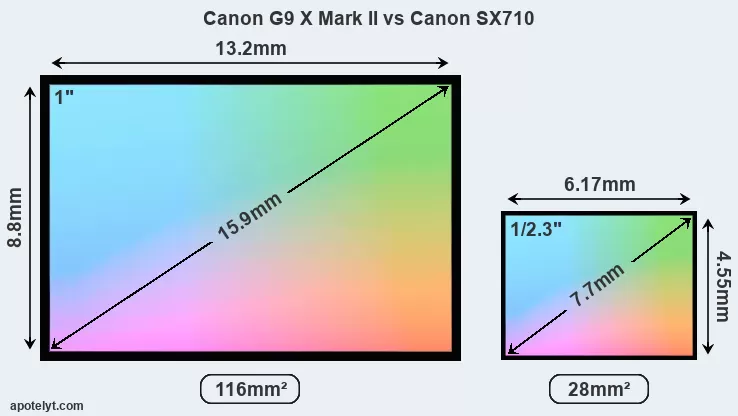
Despite having a smaller sensor, the SX710 offers a slightly higher resolution of 20.2 megapixels, compared with 20 MP of the G9X Mark II. This megapixels advantage comes at the cost of a higher pixel density and a smaller size of the individual pixel (with a pixel pitch of 1.18μm versus 2.41μm for the G9X Mark II). Moreover, it should be noted that the G9X Mark II is much more recent (by 2 years) than the SX710, and its sensor will have benefitted from technological advances during this time that further enhance the light gathering capacity of its pixels. Coming back to sensor resolution, it should be mentioned that the SX710 has no anti-alias filter installed, so that it can capture all the detail its sensor resolves.
The Canon PowerShot G9 X Mark II has a native sensitivity range from ISO 125 to ISO 12800. The corresponding ISO settings for the Canon PowerShot SX710 HS are ISO 80 to ISO 3200 (no boost).
Technology-wise, both cameras are equipped with BSI-CMOS (Backside Illuminated Complementary Metal–Oxide–Semiconductor) sensors. Both cameras use a Bayer filter for capturing RGB colors on a square grid of photosensors. This arrangement is found in most digital cameras.
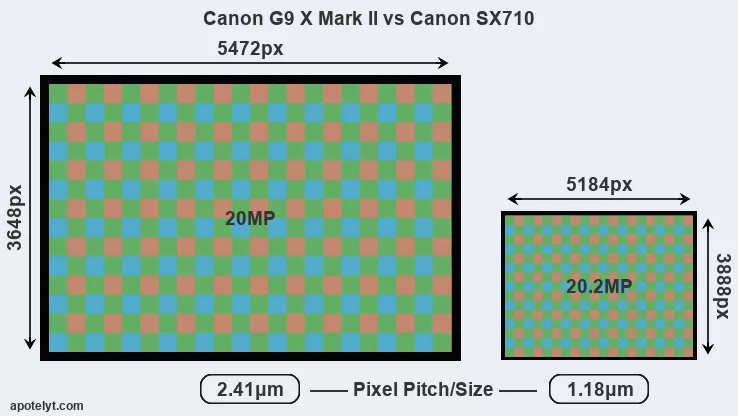
Since 2007, DXO Mark has published sensor performance measurements that have been derived using a consistent methodology. This service assesses and scores the color depth ("DXO Portrait"), dynamic range ("DXO Landscape"), and low-light sensitivity ("DXO Sports") of camera sensors, and also publishes an overall camera score. The table below summarizes the physical sensor characteristics and sensor quality findings and compares them across a set of similar cameras.

| Camera Model |
Sensor Class |
Resolution (MP) |
Horiz. Pixels |
Vert. Pixels |
Video Format |
DXO Portrait |
DXO Landscape |
DXO Sports |
DXO Overall |
||
|---|---|---|---|---|---|---|---|---|---|---|---|
| 1. | Canon G9 X Mark II | 1-inch | 20.0 | 5472 | 3648 | 1080/60p | 21.9 | 12.5 | 522 | 65 | |
| 2. | Canon SX710 | 1/2.3 | 20.2 | 5184 | 3888 | 1080/60p | 20.2 | 11.6 | 712 | 47 | |
| 3. | Canon 200D | APS-C | 24.0 | 6000 | 4000 | 1080/60p | 23.6 | 13.4 | 1041 | 79 | |
| 4. | Canon 1300D | APS-C | 17.9 | 5184 | 3456 | 1080/30p | 22.0 | 11.7 | 781 | 66 | |
| 5. | Canon 2000D | APS-C | 24.0 | 6000 | 4000 | 1080/30p | 22.6 | 11.9 | 1009 | 71 | |
| 6. | Canon G7 X | 1-inch | 20.0 | 5472 | 3648 | 1080/60p | 23.0 | 12.7 | 556 | 71 | |
| 7. | Canon G7 X Mark II | 1-inch | 20.0 | 5472 | 3648 | 1080/60p | 21.8 | 11.9 | 260 | 62 | |
| 8. | Canon G9 X | 1-inch | 20.0 | 5472 | 3648 | 1080/60p | 21.5 | 12.3 | 495 | 63 | |
| 9. | Canon M100 | APS-C | 24.0 | 6000 | 4000 | 1080/60p | 23.5 | 12.9 | 1272 | 78 | |
| 10. | Canon S120 | 1/1.7 | 12.0 | 4000 | 3000 | 1080/60p | 21.3 | 11.9 | 246 | 56 | |
| 11. | Canon SX70 | 1/2.3 | 20.2 | 5184 | 3888 | 4K/30p | 20.6 | 12.1 | 1063 | 51 | |
| 12. | Canon SX420 | 1/2.3 | 19.9 | 5152 | 3864 | 720/25p | 20.3 | 11.7 | 806 | 48 | |
| 13. | Canon SX620 | 1/2.3 | 20.2 | 5184 | 3888 | 1080/30p | 20.4 | 11.8 | 838 | 49 | |
| 14. | Canon SX700 | 1/2.3 | 15.9 | 4608 | 3456 | 1080/60p | 20.1 | 11.4 | 629 | 45 | |
| 15. | Canon SX720 | 1/2.3 | 20.2 | 5184 | 3888 | 1080/60p | 20.3 | 11.8 | 817 | 48 | |
| 16. | Sony HX95 | 1/2.3 | 18.0 | 4896 | 3672 | 4K/30p | 20.6 | 12.1 | 1057 | 51 | |
| 17. | Sony HX99 | 1/2.3 | 18.0 | 4896 | 3672 | 4K/30p | 20.6 | 12.1 | 1058 | 51 | |
| Note: DXO values in italics represent estimates based on sensor size and age. | |||||||||||
Many modern cameras are not only capable of taking still images, but also of capturing video footage. The two cameras under consideration both have sensors whose read-out speed is fast enough to capture moving pictures, and both provide the same movie specifications (1080/60p).
Feature comparison
Apart from body and sensor, cameras can and do differ across a variety of features. The G9X Mark II and the SX710 are similar in the sense that neither of the two has a viewfinder. The images are, thus, framed using live view on the rear LCD. The following table reports on some other key feature differences and similarities of the Canon G9 X Mark II, the Canon SX710, and comparable cameras.

| Camera Model |
Viewfinder (Type or 000 dots) |
Control Panel (yes/no) |
LCD Specifications (inch/000 dots) |
LCD Attach- ment |
Touch Screen (yes/no) |
Max Shutter Speed * |
Max Shutter Flaps * |
Built-in Flash (yes/no) |
Built-in Image Stab |
||
|---|---|---|---|---|---|---|---|---|---|---|---|
| 1. | Canon G9 X Mark II | none | n | 3.0 / 1040 | fixed | Y | 1/2000s | 8.2/s | Y | Y | |
| 2. | Canon SX710 | none | n | 3.0 / 922 | fixed | n | 1/3200s | 6.0/s | Y | Y | |
| 3. | Canon 200D | optical | n | 3.0 / 1040 | swivel | Y | 1/4000s | 5.0/s | Y | n | |
| 4. | Canon 1300D | optical | n | 3.0 / 920 | fixed | n | 1/4000s | 3.0/s | Y | n | |
| 5. | Canon 2000D | optical | n | 3.0 / 920 | fixed | n | 1/4000s | 3.0/s | Y | n | |
| 6. | Canon G7 X | none | n | 3.0 / 1040 | tilting | Y | 1/2000s | 6.5/s | Y | Y | |
| 7. | Canon G7 X Mark II | none | n | 3.0 / 1040 | tilting | Y | 1/2000s | 8.0/s | Y | Y | |
| 8. | Canon G9 X | none | n | 3.0 / 1040 | fixed | Y | 1/2000s | 6.0/s | Y | Y | |
| 9. | Canon M100 | none | n | 3.0 / 1040 | tilting | Y | 1/4000s | 6.1/s | Y | n | |
| 10. | Canon S120 | none | n | 3.0 / 922 | fixed | Y | 1/2000s | 12.1/s | Y | Y | |
| 11. | Canon SX70 | 2360 | n | 3.0 / 922 | swivel | n | 1/2000s | 10.0/s | Y | Y | |
| 12. | Canon SX420 | none | n | 3.0 / 230 | fixed | n | 1/4000s | 0.5/s | Y | Y | |
| 13. | Canon SX620 | none | n | 3.0 / 922 | fixed | n | 1/2000s | 2.5/s | Y | Y | |
| 14. | Canon SX700 | none | n | 3.0 / 922 | fixed | n | 1/3200s | 8.5/s | Y | Y | |
| 15. | Canon SX720 | none | n | 3.0 / 922 | fixed | n | 1/3200s | 5.9/s | Y | Y | |
| 16. | Sony HX95 | 638 | n | 3.0 / 922 | tilting | n | 1/2000s | 10.0/s | Y | Y | |
| 17. | Sony HX99 | 638 | n | 3.0 / 922 | tilting | Y | 1/2000s | 10.0/s | Y | Y | |
| Note: *) Information refers to the mechanical shutter, unless the camera only has an electronic one. | |||||||||||
One differentiating feature between the two cameras concerns the touch sensitivity of the rear screen. The G9X Mark II has a touchscreen, while the SX710 has a conventional panel. Touch control can be particularly helpful, for example, for setting the focus point.
The Canon G9 X Mark II has an intervalometer built-in. This enables the photographer to capture time lapse sequences, such as flower blooming, a sunset or moon rise, without purchasing an external camera trigger and related software.
Both the G9X Mark II and the SX710 have zoom lenses built in. The G9X Mark II has a 28-84mm f/2.0-4.9 optic and the SX710 offers a 25-750mm f/3.2-6.9 (focal lengths in full frame equivalent terms). Hence, the SX710 provides a wider angle of view at the short end, as well as more tele-photo reach at the long end than the G9X Mark II. The G9X Mark II offers the faster maximum aperture.
Concerning the storage of imaging data, both the G9X Mark II and the SX710 write their files to SDXC cards. Both cameras can use UHS-I cards, which provide for Ultra High Speed data transfer of up to 104 MB/s.
Connectivity comparison
For some imaging applications, the extent to which a camera can communicate with its environment can be an important aspect in the camera decision process. The table below provides an overview of the connectivity of the Canon PowerShot G9 X Mark II and Canon PowerShot SX710 HS and, in particular, the interfaces the cameras (and selected comparators) provide for accessory control and data transfer.

| Camera Model |
Hotshoe Port |
Internal Mic / Speaker |
Microphone Port |
Headphone Port |
HDMI Port |
USB Port |
WiFi Support |
NFC Support |
Bluetooth Support |
||
|---|---|---|---|---|---|---|---|---|---|---|---|
| 1. | Canon G9 X Mark II | - | stereo / mono | - | - | micro | 2.0 | Y | Y | Y | |
| 2. | Canon SX710 | - | stereo / mono | - | - | micro | 2.0 | Y | Y | - | |
| 3. | Canon 200D | Y | stereo / mono | Y | - | mini | 2.0 | Y | Y | Y | |
| 4. | Canon 1300D | Y | mono / mono | - | - | mini | 2.0 | Y | Y | - | |
| 5. | Canon 2000D | Y | mono / mono | - | - | mini | 2.0 | Y | Y | - | |
| 6. | Canon G7 X | - | stereo / mono | - | - | micro | 2.0 | Y | Y | - | |
| 7. | Canon G7 X Mark II | - | stereo / mono | - | - | micro | 2.0 | Y | Y | - | |
| 8. | Canon G9 X | - | stereo / mono | - | - | micro | 2.0 | Y | Y | - | |
| 9. | Canon M100 | - | stereo / mono | - | - | micro | 2.0 | Y | Y | Y | |
| 10. | Canon S120 | - | stereo / mono | - | - | mini | 2.0 | Y | - | - | |
| 11. | Canon SX70 | - | stereo / mono | Y | - | micro | 2.0 | Y | - | Y | |
| 12. | Canon SX420 | - | mono / mono | - | - | - | 2.0 | Y | Y | - | |
| 13. | Canon SX620 | - | mono / mono | - | - | micro | 2.0 | Y | Y | - | |
| 14. | Canon SX700 | - | stereo / mono | - | - | micro | 2.0 | Y | Y | - | |
| 15. | Canon SX720 | - | stereo / mono | - | - | micro | 2.0 | Y | Y | - | |
| 16. | Sony HX95 | - | stereo / mono | - | - | micro | 2.0 | Y | Y | Y | |
| 17. | Sony HX99 | - | stereo / mono | - | - | micro | 2.0 | Y | Y | Y |
Both the G9X Mark II and the SX710 have been discontinued, but can regularly be found used on ebay. The SX710 was replaced by the Canon SX720, while the G9X Mark II does not have a direct successor. Further information on the features and operation of the G9X Mark II and SX710 can be found, respectively, in the Canon G9 X Mark II Manual (free pdf) or the online Canon SX710 Manual.
Review summary
So how do things add up? Is the Canon G9 X Mark II better than the Canon SX710 or vice versa? Below is a summary of the relative strengths of each of the two contestants.
Arguments in favor of the Canon PowerShot G9 X Mark II:
- Better moiré control: Has an anti-alias filter to avoid artificial patterns to appear in images.
- Better image quality: Features a larger and more technologically advanced imaging sensor.
- Richer colors: The sensor size advantage translates into images with better, more accurate colors.
- More dynamic range: Larger sensor captures a wider spectrum of light and dark details.
- Better low-light sensitivity: Larger sensor produces good images even in poorly lit environments.
- Better jpgs: Has a more modern image processing engine (DIGIC 7 vs DIGIC 6).
- More detailed LCD: Has a higher resolution rear screen (1040k vs 922k dots).
- Fewer buttons to press: Is equipped with a touch-sensitive rear screen to facilitate handling.
- Faster burst: Shoots at higher frequency (8.2 vs 6 flaps/sec) to capture the decisive moment.
- Easier time-lapse photography: Has an intervalometer built-in for low frequency shooting.
- Better light gathering: Has a lens with a wider maximum aperture (f/2.0 vs f/3.2).
- More compact: Is smaller (98x58mm vs 113x66mm) and thus needs less room in the bag.
- Less heavy: Is lighter (by 63g or 23 percent) and hence easier to carry around.
- Easier travel charging: Can be conveniently charged via its USB port.
- Easier wireless transfer: Supports Bluetooth for image sharing without cables.
- More modern: Is somewhat more recent (announced 2 years after the SX710).
Reasons to prefer the Canon PowerShot SX710 HS:
- Maximized detail: Lacks an anti-alias filter to exploit the sensor's full resolution potential.
- Faster shutter: Has higher mechanical shutter speed (1/3200s vs 1/2000s) to freeze action.
- Wider view: Has a wider-angle lens that facilitates landscape or interior shots.
- More tele-reach: Has a longer tele-lens for perspective compression and subject magnification.
- More affordable: Was introduced into a lower priced category (34 percent cheaper at launch).
- More heavily discounted: Has been on the market for longer (launched in January 2015).
If the count of relative strengths (bullet points above) is taken as a measure, the G9X Mark II is the clear winner of the match-up (16 : 6 points). However, the relevance of individual strengths will vary across photographers, so that you might want to apply your own weighing scheme to the summary points when reflecting and deciding on a new camera. A professional wildlife photographer will view the differences between cameras in a way that diverges from the perspective of a family photog, and a person interested in architecture has distinct needs from a sports shooter. Hence, the decision which camera is best and worth buying is often a very personal one.
How about other alternatives? Do the specifications of the Canon G9 X Mark II and the Canon SX710 place the cameras among the top in their class? Find out in the latest Best Travel-Zoom Camera and Best Superzoom Camera listings whether the two cameras rank among the cream of the crop.
In any case, while the comparison of technical specifications can provide a useful overview of the capabilities of different cameras, it remains partial and cannot reveal, for example, the shooting experience and imaging performance when actually working with the G9X Mark II or the SX710. User reviews, such as those found at amazon, can sometimes inform about these issues, but such feedback is often incomplete, inconsistent, and biased.
Expert reviews
This is why hands-on reviews by experts are important. The table below provides a synthesis of the camera assessments of some of the best known photo-gear review sites (amateurphotographer [AP], cameralabs [CL], digitalcameraworld [DCW], dpreview [DPR], ephotozine [EPZ], photographyblog [PB]). As can be seen, the professional reviewers agree in many cases on the quality of different cameras, but sometimes their assessments diverge, reinforcing the earlier point that a camera decision is often a very personal choice.

| Camera Model |
AP score |
CL score |
DCW score |
DPR score |
EPZ score |
PB score |
Camera Launch |
Launch Price (USD) |
Street Price |
||
|---|---|---|---|---|---|---|---|---|---|---|---|
| 1. | Canon G9 X Mark II | 4/5 | .. | 4/5 | 75/100 | 4.5/5 | 4.5/5 | Jan 2017 | 529 | ebay.com | |
| 2. | Canon SX710 | .. | + | .. | .. | 4/5 | 3.5/5 | Jan 2015 | 349 | ebay.com | |
| 3. | Canon 200D | 4/5 | + + | 4/5 | 78/100 | 4.5/5 | 4.5/5 | Jun 2017 | 549 | ebay.com | |
| 4. | Canon 1300D | 4/5 | o | 4/5 | 73/100 | 4/5 | 4/5 | Mar 2016 | 449 | ebay.com | |
| 5. | Canon 2000D | 3/5 | o | 3.5/5 | .. | 3.5/5 | 3.5/5 | Feb 2018 | 449 | amazon.com | |
| 6. | Canon G7 X | 4/5 | + + | .. | 77/100 | 4.5/5 | 4.5/5 | Sep 2014 | 699 | ebay.com | |
| 7. | Canon G7 X Mark II | 4.5/5 | + + | .. | 81/100 | 4.5/5 | 4.5/5 | Feb 2016 | 699 | ebay.com | |
| 8. | Canon G9 X | 3.5/5 | + + | .. | .. | 4.5/5 | 4.5/5 | Oct 2015 | 529 | ebay.com | |
| 9. | Canon M100 | 3/5 | + | .. | .. | 4/5 | 3.5/5 | Aug 2017 | 499 | ebay.com | |
| 10. | Canon S120 | .. | + + | .. | .. | 4.5/5 | 4.5/5 | Aug 2013 | 449 | ebay.com | |
| 11. | Canon SX70 | .. | + + | 3.5/5 | .. | 3.5/5 | 3.5/5 | Sep 2018 | 549 | amazon.com | |
| 12. | Canon SX420 | .. | .. | .. | .. | .. | 3/5 | Jan 2016 | 299 | ebay.com | |
| 13. | Canon SX620 | .. | .. | .. | .. | .. | 4/5 | May 2016 | 279 | ebay.com | |
| 14. | Canon SX700 | .. | + + | .. | .. | 4/5 | 4/5 | Feb 2014 | 349 | ebay.com | |
| 15. | Canon SX720 | .. | + | .. | .. | 4/5 | 4.5/5 | Feb 2016 | 379 | ebay.com | |
| 16. | Sony HX95 | .. | .. | .. | .. | .. | .. | Aug 2018 | 429 | ebay.com | |
| 17. | Sony HX99 | .. | .. | .. | .. | 4/5 | 4.5/5 | Aug 2018 | 449 | ebay.com | |
| Note: (+ +) highly recommended; (+) recommended; (o) reviewed; (..) not available. | |||||||||||
The review scores listed above should be treated with care, though. The ratings are only valid when referring to cameras in the same category and of the same age. Hence, a score should always be seen in the context of the camera's market launch date and its price, and rating-comparisons among cameras that span long time periods or concern very differently equipped models make little sense. Also, kindly note that some of the listed sites have over time developped their review approaches and their reporting style.

Check G9X Mark II offers at
ebay.com

Check SX710 offers at
ebay.com
Other camera comparisons
Did this review help to inform your camera decision process? In case you would like to check on the differences and similarities of other camera models, just make your choice using the following search menu. Alternatively, you can follow any of the listed hyperlinks for comparisons that others found interesting.
- Canon 5D vs Canon G9 X Mark II
- Canon 600D vs Canon G9 X Mark II
- Canon D30 vs Canon SX710
- Canon G9 X Mark II vs Nikon D40X
- Canon G9 X Mark II vs Panasonic G110
- Canon G9 X Mark II vs Sony A6600
- Canon G9 X Mark II vs Sony RX10
- Canon SX710 vs Canon XT
- Canon SX710 vs Nikon B600
- Canon SX710 vs Panasonic TS7
- Canon SX710 vs Pentax K-1 II
- Canon SX710 vs Sony H200
Specifications: Canon G9 X Mark II vs Canon SX710
Below is a side-by-side comparison of the specs of the two cameras to facilitate a quick review of their differences and common features.
| Camera Model | Canon G9 X Mark II | Canon SX710 |
|---|---|---|
| Camera Type | Fixed lens compact camera | Fixed lens compact camera |
| Camera Lens | 28-84mm f/2.0-4.9 | 25-750mm f/3.2-6.9 |
| Launch Date | January 2017 | January 2015 |
| Launch Price | USD 529 | USD 349 |
| Sensor Specs | Canon G9 X Mark II | Canon SX710 |
| Sensor Technology | BSI-CMOS | BSI-CMOS |
| Sensor Format | 1" Sensor | 1/2.3" Sensor |
| Sensor Size | 13.2 x 8.8 mm | 6.17 x 4.55 mm |
| Sensor Area | 116.16 mm2 | 28.0735 mm2 |
| Sensor Diagonal | 15.9 mm | 7.7 mm |
| Crop Factor | 2.7x | 5.6x |
| Sensor Resolution | 20 Megapixels | 20.2 Megapixels |
| Image Resolution | 5472 x 3648 pixels | 5184 x 3888 pixels |
| Pixel Pitch | 2.41 μm | 1.18 μm |
| Pixel Density | 17.18 MP/cm2 | 71.80 MP/cm2 |
| Moiré control | Anti-Alias filter | no AA filter |
| Movie Capability | 1080/60p Video | 1080/60p Video |
| ISO Setting | 125 - 12,800 ISO | 80 - 3,200 ISO |
| Image Processor | DIGIC 7 | DIGIC 6 |
| DXO Sensor Quality (score) | 65 | .. |
| DXO Color Depth (bits) | 21.9 | .. |
| DXO Dynamic Range (EV) | 12.5 | .. |
| DXO Low Light (ISO) | 522 | .. |
| Screen Specs | Canon G9 X Mark II | Canon SX710 |
| Viewfinder Type | no viewfinder | no viewfinder |
| LCD Framing | Live View | Live View |
| Rear LCD Size | 3.0inch | 3.0inch |
| LCD Resolution | 1040k dots | 922k dots |
| LCD Attachment | Fixed screen | Fixed screen |
| Touch Input | Touchscreen | no Touchscreen |
| Shooting Specs | Canon G9 X Mark II | Canon SX710 |
| Focus System | Contrast-detect AF | Contrast-detect AF |
| Manual Focusing Aid | Focus Peaking | no Peaking Feature |
| Continuous Shooting | 8.2 shutter flaps/s | 6 shutter flaps/s |
| Time-Lapse Photography | Intervalometer built-in | no Intervalometer |
| Fill Flash | Built-in Flash | Built-in Flash |
| Storage Medium | SDXC cards | SDXC cards |
| Single or Dual Card Slots | Single card slot | Single card slot |
| UHS card support | UHS-I | UHS-I |
| Connectivity Specs | Canon G9 X Mark II | Canon SX710 |
| External Flash | no Hotshoe | no Hotshoe |
| USB Connector | USB 2.0 | USB 2.0 |
| HDMI Port | micro HDMI | micro HDMI |
| Wifi Support | Wifi built-in | Wifi built-in |
| Near-Field Communication | NFC built-in | NFC built-in |
| Bluetooth Support | Bluetooth built-in | no Bluetooth |
| Body Specs | Canon G9 X Mark II | Canon SX710 |
| Battery Type | Canon NB-13L | Canon NB-6LH |
| Battery Life (CIPA) | 235 shots per charge | 230 shots per charge |
| In-Camera Charging | USB charging | no USB charging |
| Body Dimensions |
98 x 58 x 31 mm (3.9 x 2.3 x 1.2 in) |
113 x 66 x 35 mm (4.4 x 2.6 x 1.4 in) |
| Camera Weight | 206 g (7.3 oz) | 269 g (9.5 oz) |

Check G9X Mark II offers at
ebay.com

Check SX710 offers at
ebay.com
Did you notice an error on this page? If so, please get in touch, so that we can correct the information.
